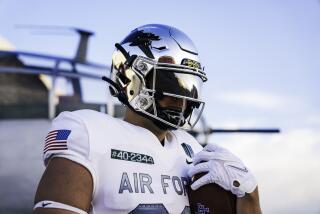Marine Corps Redesigns Its Combat ‘Camies’
- Share via
CAMP PENDLETON — Clothes, we are told, do not make the man. But they can certainly make the fighting man more effective.
With that in mind, the Marine Corps is doing something it does only rarely, and then only with considerable forethought: tinkering with tradition.
For the first time since the Vietnam War, the corps is changing the look of its camouflage uniforms, known as “utilities” or “camies,” which are worn for training and, when necessary, for combat.
The new camies are meant to make the Marines more comfortable in training, more stealthy and lethal in battle.
“The last man to adapt on the battlefield is the first to die,” said Sgt. James Law, one of several dozen infantry Marines chosen to field-test the new look. Other Marines are doing the same at the Marine Corps Air Ground Combat Center in Twentynine Palms and at bases in the Far East.
For openers, the old style of alternating blotches of brown, black and green is being replaced by a computer-generated design of black and green pixels, those tiny dots that, seen from a distance, form an image.
There are other changes: slanted breast pockets, improved cargo pockets, zip-off sleeves for summer wear, new hats (covers), and padding for knees and elbows. The Marine Corps believes that battles of the future will most likely be fought in urban locations, with plenty of concrete, and thus the need for padding.
“Form must follow function,” Sgt. Jason Booth said.
As in any large organization, there is a certain measure of resistance to change in the Marine Corps. The current camies--starched to a cardboard-like stiffness, with sharp creases on the legs--have been the image of the squared-away Marine for a quarter-century.
But the uniform change is being pitched to the troops in a way destined to make it more acceptable. For openers, the idea is being pushed by the commandant, Gen. James Jones.
And the three reasons for the change, as outlined by Maj. Gabriel Patricio, the officer in charge of the switch, are sure to reach sympathetic ears: increased durability, increased combat effectiveness, greater distinctiveness.
The new camies are wash-and-wear--no more ironing and starching. In an experiment involving Marine Corps snipers, the new design was judged to allow Marines to hide unseen in the brush more easily than the old style did.
“Survivability is important to Marines,” Law said.
Once the new look is adopted corps-wide this spring or summer, the Marines will also look different from their brethren in the Army, which also uses the traditional camouflage uniform.
“I think it’s outstanding that we’re trying to set ourselves apart,” said Pvt. 1st Class Chris Baumgartner.
Even as the corps comes into the age of durable, lightweight fibers and computer designs, it is also reaching back to a fashion statement dating back more than a century.
Among the innovations being considered is the addition of gaiters, cloth coverings for the calf, instep and ankle--the macho cousin of spats. Gaiters were de rigueur for Marines in both world wars but were replaced in recent decades.
Held in place by a zipper in the back and laces on the sides, the gaiters help tuck in the pant legs to prevent the intrusion of bugs and other crawly things common to humid and desert climates. The bugs in Kuwait, for example, were rated as man-eaters.
Several accessories on the new camies are still under review. There is concern that the Velcro and buttons make too much noise. Noise can decrease survivability.
“Unnatural noise in the field carries a long way,” said Cpl. Antonio Espera. “Velcro is an unnatural noise.”
At Camp Pendleton, the new camies are being tested in an amphibious environment, at Twentynine Palms, in the desert, and in Japan and Okinawa, in cold weather and the jungle. For the desert, different colors are planned.
To boost morale and protect the patent on the design, the new camies will have tiny eagle-globe-and-anchor emblems dotted about the fabric, visible only upon the closest of inspections.
Some things will not change. The shirts will have only the Marine’s name and the title U.S. Marine. There will be no patches for individual divisions or brigades or other subunits.
“That’s like something the Army does,” said several of the Marines, in a voice that explained why the idea is unacceptable to the Marine Corps.

